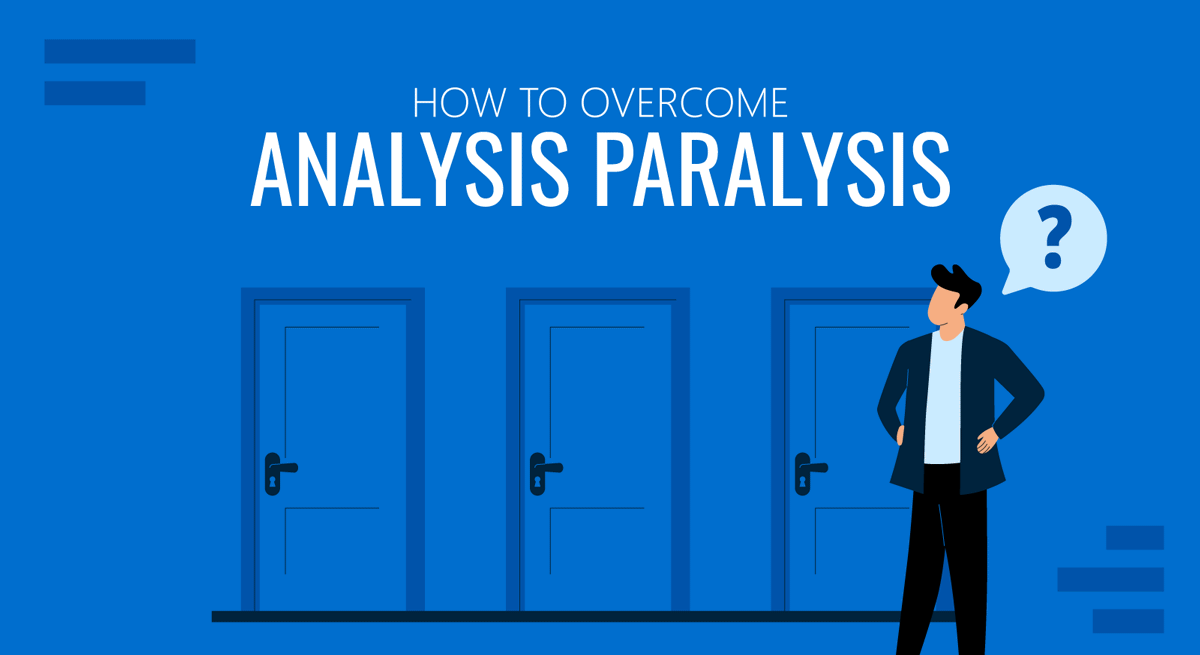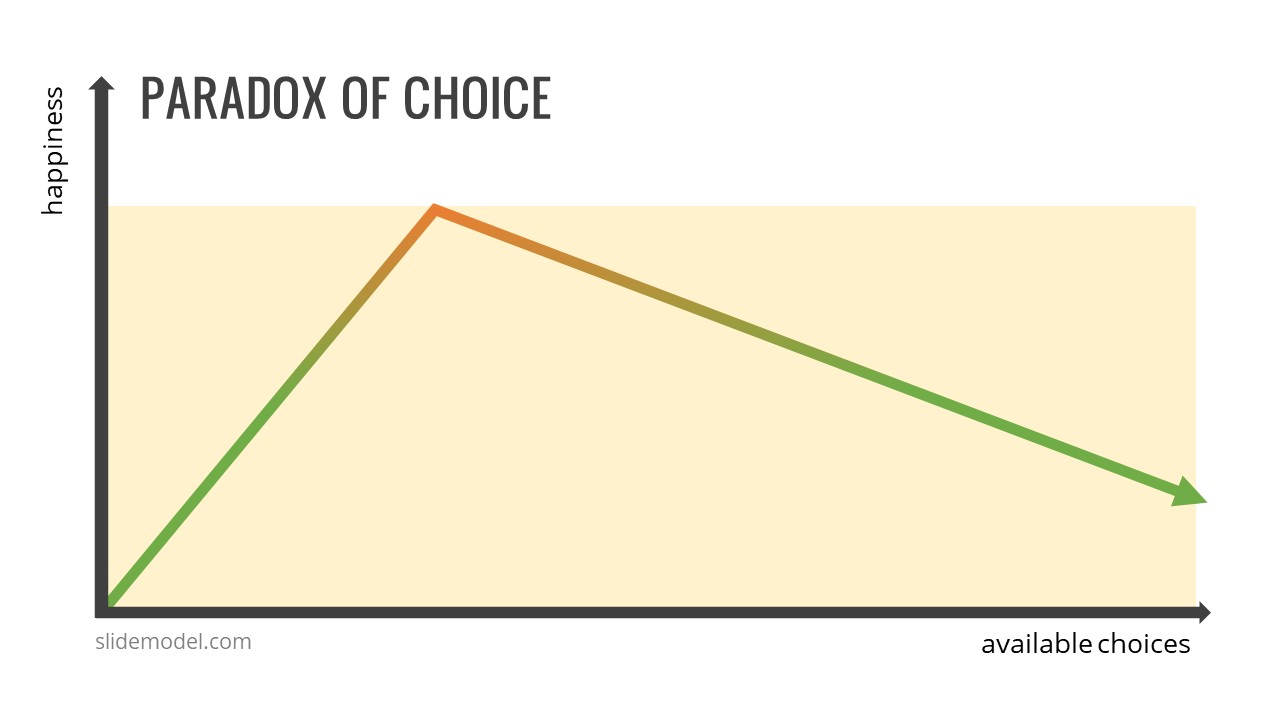
Many people who believe they’re not good at making decisions are actually not all that bad at coming up with the right decision, provided they can overcome their tendency of overthinking and procrastinating decision-making. In other words, they simply suffer from Analysis Paralysis. There are a few things that can help you overcome this tendency and make better decisions based on the best possible option.
Table of Content
- Are You Suffering from Analysis Paralysis?
- Symptoms of Decision-Making Woes
- The Paradox of Choice – More is Less
- How to Overcome Analysis Paralysis?
- Prioritize Decision Making
- Set Timelines to Ensure you don’t Procrastinate Decision Making
- Review your Objectives to Make Decisions
- Eliminate Potentially Bad Options
- Consult your Team or a Group of Experts
- Start with Small Decisions to Analyze Short-Term Results
- Proceed with the Best Option
- Analyze Decisions at Each Step
- Embracing Failure as a Stepping Stone
- Taking Calculated Risks for Success
- Effective Decision-Making Strategies
- Course Correction in Decision Making
- Final Words
Are You Suffering from Analysis Paralysis?
Before we dwell on how to overcome Analysis Paralysis, let’s first diagnose the symptoms. There are a number of signs which can help you determine if you suffer from decision-making woes. These include; procrastination in decision-making till the last moment, overthinking without finding clarity in decision-making, being unable to prioritize decision-making for big and small decisions, short-term, haphazard decisions, and the urge to avoid making decisions on your own to escape any possible blame in case things go south. This is by no means an exhaustible list. However, it can help you analyze if you have issues with decision-making that need to be fixed!

Symptoms of Decision-Making Woes
Decision-making is an essential part of life that requires a strong inhibition to choose the best outcomes. Hence, running into a spiral of analysis paralysis should not be an obstacle but a rather simple problem to skilfully solve. Identifying the root cause is essential to solve any problem. To do that, let us take a closer look at some of the symptoms of analysis paralysis.
Brain Fog: Many decision-makers experience brain fog, where they cannot comprehend the severity of a decision due to exhaustion and lack of clarity.
Dissatisfaction: If you find yourself contemplating even after making a decision, it might be a symptom of analysis paralysis.
Impulsivity: Many essential business decisions require urgency and alertness. However, procrastination and brain fog make it difficult to make these decisions on time. This is when impulsivity takes control, and you may make unplanned and reckless decisions.
The Paradox of Choice – More is Less
The modern world is adept with an array of business choices to choose from, no matter how small they may be. One might think that having more options can help you assess and pick the best fit for your needs.
However, multiple options can lead to major indecisiveness, as decision-makers often fear they will make the wrong choice. It also confuses and poses a possibility of missing out on other “good” options. This is known as the paradox of choice, where more actually offers less as it causes stress by abundance.
It promotes decision fatigue and ultimately leads the decision-maker to a spiral of analysis paralysis.
How to Overcome Analysis Paralysis?
Analysis Paralysis is easier to overcome than you might think. In fact, you can spearhead decision-making and make the most out of your opportunities by simply following a few steps. The below-mentioned tips can be useful for decision-making not just at the workplace but also in personal life or when exploring options for reaching those elusive life goals.

1. Prioritize Decision Making
Prioritizing decision-making is the first step in making better and more timely decisions. You can look into three of the following aspects when prioritizing decisions.
To overcome your decision-making conundrum, you can begin by prioritizing decision-making. You can give more preference to big decisions, which are more important, compared to smaller decisions which might not be all that important or don’t have the ability to have a significant impact on your business, job, or life. You can also create lists or write down decisions that need to be made to prioritize them according to need.
b. Immediate Vs. Less Pressing Decisions
When prioritizing decisions, see which ones are more immediate. You can add the less pressing decisions down the queue; however, you will have to ensure that they, too, aren’t delayed unnecessarily later on. More urgent decisions can be looked into as a priority; these might include both big or small decisions which need to be made sooner.
c. Short Term Vs Long Term Decisions
Whether you’re making a small or big decision, you should consider its implications. Some decisions will have a short-term impact, whereas others will have more profound implications. You should consider decisions that are more immediate with long-term implications in your high-priority list.
2. Set Timelines to Ensure you don’t Procrastinate Decision Making
One of the factors which can exacerbate Analysis Paralysis is procrastination. In a previous post, we explained how to overcome procrastination, you can use the tips from our post to ensure that you can overcome procrastination. As mentioned earlier, you should prioritize decisions and focus on the more pressing ones first. You can set timelines and also visualize your decisions in the form of PowerPoint timeline slides or cause and effect diagrams to better focus on decision making.
3. Review your Objectives to Make Decisions
a. Define Clear Business Objectives
To choose what is best for your goals, it is important to know what you intend to achieve. This can lead to effective decision-making. Be it your business-related decisions, a decision related to your job, school assignment, or personal life, you should be clear-headed about your objectives and what you need to achieve them.
b. Write Down Your Objectives
A good exercise in gaining clarity on your objectives is writing them down. This will ensure that you are able to assess the goals more optimally and without any distractions.
4. Eliminate Potentially Bad Options
a. Consider All Your Options
Once you have identified your objectives, you can consider your options and eliminate the bad ones. Such an approach will help you identify the potentially good options and narrow down the best possible outcome.
b. Seek External Input
You can also seek help from friends, colleagues, or family members to assess your options. This step can help if you are stuck in a spiral of overthinking all your choices. It will offer a fresh perspective and help eliminate options that do not work.
5. Consult your Team or a Group of Experts
a. Gain Insights From Multiple Perspectives
When identifying and eliminating bad options, it is best to seek advice from multiple people to see which options stand out as the best and the worst in the opinion of most people. This can help you consider various options and learn from the experiences of multiple people.
b. Leverage Expert Advice for Informed Decision-Making
Seeking advice from professionals with some experience with the subject at hand can be an even better opportunity to streamline your decision-making process. For example, if you are making a decision related to an investment in a venture, a financial expert or entrepreneur who has worked on a similar venture can give you important insights into market conditions, financial risks, supply shocks, etc. This will eliminate the uncertainties about the subject and provide more informed options.
6. Start with Small Decisions to Analyze Short-Term Results
a. Importance of Testing the Waters with Pilot Projects
If possible, you can opt for small decisions first and gradually make your way to making bigger decisions. For example, a pilot project might require less investment to test the results before you opt to make a large investment. This can help you understand and analyze what aspects of your project work and what needs more focus.
b. Gaining Valuable Insights for Longer Decisions
The same rule can be applied to other aspects of life, such as testing people’s reactions (e.g., a boss, colleague, or peer) when dealing with them to see what ticks them off and what does not. Certain bosses will allow innovation to a certain degree, whereas others can be more open to trying new things. Knowing what works and what does not can help you make more informed decisions in the long run.
Making smaller, less risky decisions can help you pave the way to bigger ones while giving you much-needed insight into the potential pitfalls.
7. Proceed with the Best Option
a. Proceed With the Option that Fits Your End Goal
Needless to say, you will eventually need to proceed with the best possible option. Remember, there is no guarantee of success. However, you can identify the most rational choice, depending on the method of elimination and selection based on test projects and expert opinions.
b. Focus on Course Correction
Overcoming your analysis by paralysis with expert help, decision-making strategies, and testing is a great way to find what works for you. This can also help decision-makers assess their past mistakes and engage in course correction, making it a lot easier.
8. Analyze Decisions at Each Step
Even the best and most rational decisions can have pitfalls. Therefore, it is best to analyze your decisions at each step.
Importance of Ongoing Analysis
An ongoing analysis of your decision can help you track your progress and identify any errors, problem areas, or areas draining resources in the long term. It can help you formulate effective strategies that can streamline the entire decision-making procedure.
You can track data metrics such as time taken to make every decision, outcome of decisions compared to time taken, hierarchy of the decision-making process, elimination of choices, and much more. This helps save time, energy, and resources and avoids analysis by paralysis in decision-making executives.
The ongoing analysis additionally instills self-confidence in an individual to make better decisions in a much shorter time without overthinking as they can see the results their decisions bring.
Baseline, Midline, and Endline
You might have heard of a baseline analysis used to assess the initial circumstances tied to a project to determine progress. The midline serves as the means for course correction by assessing the midline of the project, whereas the online assesses the final results. Applying them as a mechanism to decision-making can be helpful, as well as for your projects. You can analyze the initial situation, see how the decision leads to your objectives, and make course corrections as necessary to avoid major pitfalls.
9. Embracing Failure as a Stepping Stone
a. Learning from Past Mistakes
Regardless of how good a decision may seem, there are always factors beyond your control. Therefore, it is crucial to learn from your past mistakes to achieve your future goals. Moreover, embracing these failures will help you see beyond them and do what the situation demands.
b. Overcoming the Fear of Failure
There is no guaranteed formula for successful decision-making. Frequently, it is a process of trial and error which helps improve decision-making. However, one can practice decision-making and take more risks to improve with time. Failing to take risks can lead to a state of stagnancy and no possible growth in the future.
10. Taking Calculated Risks for Success
Making decisions to succeed is a calculated gamble that requires careful consideration of all the possible probabilities. Risk is an important factor that you should embrace to achieve what you want in the long term. It is a part of any strategy that succeeds. Therefore, one should view it with curiosity rather than anguish.
Understanding the Role of Risks
One of the major driving forces in preventing decision-making and aggravating analysis paralysis is risks and failure. Decision-makers often worry about making the wrong choice and choosing the option that fails. However, risks are an integral part of the process, and objective risk analysis can help streamline the decision-making process and determine the best way to dissolve future conundrums.
For instance, if you are responsible for sourcing a set of products with no significant data to fall back on, you might source some unconventional product varieties based on your personal knowledge of the target customers. This is a risk with a probability of both success and failure
Here, accepting the risk and making a decision can offer a gamble at winning or losing, but either way, it can help you understand the market better. It also gives you an insight into various data points based on which you can make more informed decisions in the future.
Personal and Professional Development
Apart from a streamlined decision-making process, accepting risk can also help hone your personal and professional skill development. You can make more professional decisions at work and efficiently promote faster decision-making. Additionally, you can avoid missed opportunities and learn when to leverage a decision that works in your favor. This can instill immense self-confidence in decision-makers and help build a personal strategy to make important decisions.
Additionally, you are less likely to miss exciting opportunities due to the fear of failing and can strategically move past the decision paralysis stage in the future.
11. Effective Decision-Making Strategies
After making a decision, gathering data from your past choices, understanding the spiral you are stuck in, and gaining expert help, it is important to assess that data. Knowing your weaknesses in decision-making and either eliminating or streamlining them can help you achieve the best outcome in any given situation. Let us take a look at the two approaches used for this stage.
Practical Approaches for Different Situations
Different situations and choices often need different solutions. Assessing every decision from a success or failure standpoint is a mistake for many decision-makers. Some decisions are made from a long-term standpoint where they do not show immediate results or even fail in the short term. But here, consistency and long-term goals are a priority.
Similarly, some goals require quick thinking, fast decision-making, and using the opportunity when it presents itself. Analyzing all your options and putting them through rounds of tests and strategies might result in a missed opportunity.
Therefore, depending on your desired result, taking appropriate and practical approaches for different situations is vital. Having these processes in line can save you time, effort, and resources in the long term.
Empowering Sound Choices
While it may seem counterintuitive to many, most of the time, the option that works for a particular task is already right before the decision-maker. However, the paradox of choice here overpowers their ability to see through the solution clearly and confuses the decision-maker into considering other options.
One effective way to make sound decisions faster and avoid analysis paralysis is by empowering choices that have backing. Instead of considering all the choices available to you at once, you can try an approach of categorizing all the options and selecting the most suitable one.
Once you have the best choice from every category, assess your needs to select what works for you. This prevents overthinking due to excessive options and helps you think strategically about limited and necessary solutions.
12. Course Correction in Decision Making
As important as embracing risks and making swift decisions, correcting past mistakes and embracing the associated risks are equally important. Pivoting strategies can help decision-makers be more empowered to make decisions and cater to the current needs of the situation.
The Power of Adaptability
Changing decisions per the situation is no easy feat, especially if the decision was passed after an analysis paralysis spiral. Decision-makers who understand and harness the power to adapt to the situation make better decisions in the present and effectively understand their company’s needs.
Adaptability allows you to change without feeling self-conscious about your mistakes. Embracing the situation and responding with a solution accordingly can create a long-term impact on resilience.
Decision-makers are more likely to overcome negative obstacles or setbacks once they challenge their failures instead of being disappointed.
Navigating Uncertainties
Additionally, course correction and assessment of failures provide you with enough data to use when you encounter analysis paralysis. It can help you navigate through difficult and urgent decisions instantly, as your earlier knowledge is handy.
It enables you to contextualize the situation and find the solution properly. Developing self-confidence will also help you walk into uncertainty without judging your efforts and making a decision at the moment. This exceptional trait will set you apart and help you make decisions that matter in various situations.
Final Words
If you dig deep into the lives of successful people, you will notice two common things in the lives of most such people; the first is that they dared to take risks, and the second, they faced a lot of failures. The latter means bad decisions. Hence, bad decisions aren’t always a bad thing if they can help you learn and improve. Colonel Sanders, the founder of KFC, faced 1,009 rejections for his recipe before it was accepted. Thomas Edison was considered “too stupid” for school by his teachers. Walt Disney, early in his career, was told he “lacked imagination,” and even the great Albert Einstein was deemed handicapped early in his life. These people went on to achieve success in ways they may dream of replicating. Regardless of failures, the one thing you would find consistent about such individuals is their ability to take risks and not be bogged down in decision-making. Hence, Analysis Paralysis will get you nowhere and might even end up ruining your chance to do something important. Make sure you don’t let that happen. Also, check our article about decision-making for business and our collection of decision making PowerPoint templates.



Very nice and effective suggestions towards obtaining business objectives.